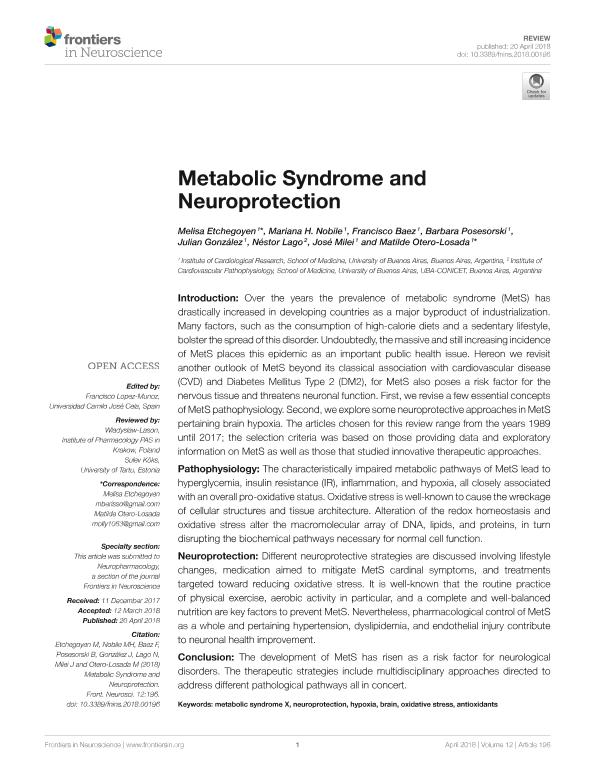Artículo
Metabolic syndrome and neuroprotection
Etchegoyen, Melisa; Nobile, Mariana H.; Baez, Francisco ; Posesorski, Barbara; González, Julian; Lago, Néstor; Milei, José; Otero-Losada, Matilde Estela
; Posesorski, Barbara; González, Julian; Lago, Néstor; Milei, José; Otero-Losada, Matilde Estela
 ; Posesorski, Barbara; González, Julian; Lago, Néstor; Milei, José; Otero-Losada, Matilde Estela
; Posesorski, Barbara; González, Julian; Lago, Néstor; Milei, José; Otero-Losada, Matilde Estela
Fecha de publicación:
04/2018
Editorial:
Frontiers Media S.A.
Revista:
Frontiers in Neuroscience
ISSN:
1662-5161
e-ISSN:
1662-453X
Idioma:
Inglés
Tipo de recurso:
Artículo publicado
Clasificación temática:
Resumen
Introduction: Over the years the prevalence of metabolic syndrome (MetS) has drastically increased in developing countries as a major byproduct of industrialization. Many factors, such as the consumption of high-calorie diets and a sedentary lifestyle, bolster the spread of this disorder. Undoubtedly, the massive and still increasing incidence of MetS places this epidemic as an important public health issue. Hereon we revisit another outlook of MetS beyond its classical association with cardiovascular disease (CVD) and Diabetes Mellitus Type 2 (DM2), for MetS also poses a risk factor for the nervous tissue and threatens neuronal function. First, we revise a few essential concepts of MetS pathophysiology. Second, we explore some neuroprotective approaches in MetS pertaining brain hypoxia. The articles chosen for this review range from the years 1989 until 2017; the selection criteria was based on those providing data and exploratory information on MetS as well as those that studied innovative therapeutic approaches. Pathophysiology: The characteristically impaired metabolic pathways of MetS lead to hyperglycemia, insulin resistance (IR), inflammation, and hypoxia, all closely associated with an overall pro-oxidative status. Oxidative stress is well-known to cause the wreckage of cellular structures and tissue architecture. Alteration of the redox homeostasis and oxidative stress alter the macromolecular array of DNA, lipids, and proteins, in turn disrupting the biochemical pathways necessary for normal cell function. Neuroprotection: Different neuroprotective strategies are discussed involving lifestyle changes, medication aimed to mitigate MetS cardinal symptoms, and treatments targeted toward reducing oxidative stress. It is well-known that the routine practice of physical exercise, aerobic activity in particular, and a complete and well-balanced nutrition are key factors to prevent MetS. Nevertheless, pharmacological control of MetS as a whole and pertaining hypertension, dyslipidemia, and endothelial injury contribute to neuronal health improvement. Conclusion: The development of MetS has risen as a risk factor for neurological disorders. The therapeutic strategies include multidisciplinary approaches directed to address different pathological pathways all in concert.
Archivos asociados
Licencia
Identificadores
Colecciones
Articulos(ININCA)
Articulos de INST.DE INVEST.CARDIOLOGICAS (I)
Articulos de INST.DE INVEST.CARDIOLOGICAS (I)
Articulos(OCA HOUSSAY)
Articulos de OFICINA DE COORDINACION ADMINISTRATIVA HOUSSAY
Articulos de OFICINA DE COORDINACION ADMINISTRATIVA HOUSSAY
Citación
Etchegoyen, Melisa; Nobile, Mariana H.; Baez, Francisco; Posesorski, Barbara; González, Julian; et al.; Metabolic syndrome and neuroprotection; Frontiers Media S.A.; Frontiers in Neuroscience; 12; APR; 4-2018; 1-14
Compartir
Altmétricas



